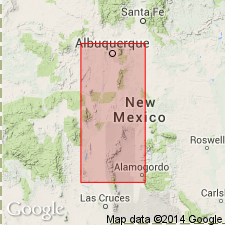
- Usage in publication:
-
- Bolander group
- Modifications:
-
- Original reference
- Dominant lithology:
-
- Limestone
- Shale
- Conglomerate
- Sandstone
- AAPG geologic province:
-
- Orogrande basin
Summary:
Pg. 27 (table 2), 51-55. Bolander group. Proposed for group of rocks of upper part of Des Moines series between top of Armendaris group (new) and base of Missouri series (above). At type section, composed largely of gray to light-gray fossiliferous limestone, several beds of fossiliferous gray shale, and one well-developed bed of conglomerate to highly conglomeratic sandstone about 70 feet below top of group. Thickness at type locality about 233 feet. [Contains abundant, typical Des Moines series fusulinids: FUSULINA, ESOSCHUBERTELLA, OZAWAINELLA?, AND MILLERELLA. Based on these fossils, age is Middle Pennsylvanian (late Des Moines).]
Type locality: just west of large box canyon in central part of Whiskey Canyon, north portion of Mud Springs Mountains, in south-central part of sec. 1, T. 13 S., R. 5 W., Sierra Co., central NM. Named from deserted village of Bolander, 8 mi northeast of Mud Springs Mountains, Sierra Co., central NM.
Source: US geologic names lexicon (USGS Bull. 1200, p. 416).
For more information, please contact Nancy Stamm, Geologic Names Committee Secretary.
Asterisk (*) indicates published by U.S. Geological Survey authors.
"No current usage" (†) implies that a name has been abandoned or has fallen into disuse. Former usage and, if known, replacement name given in parentheses ( ).
Slash (/) indicates name conflicts with nomenclatural guidelines (CSN, 1933; ACSN, 1961, 1970; NACSN, 1983, 2005, 2021). May be explained within brackets ([ ]).

